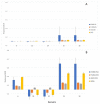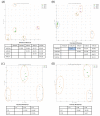Volatile-Based Diagnosis for Pathogenic Wood-Rot Fungus Fulvifomes siamensis by Electronic Nose (E-Nose) and Solid-Phase Microextraction/Gas Chromatography/Mass Spectrometry
- PMID: 37177742
- PMCID: PMC10181603
- DOI: 10.3390/s23094538
Volatile-Based Diagnosis for Pathogenic Wood-Rot Fungus Fulvifomes siamensis by Electronic Nose (E-Nose) and Solid-Phase Microextraction/Gas Chromatography/Mass Spectrometry
Abstract
Wood rot fungus Fulvifomes siamensis infects multiple urban tree species commonly planted in Singapore. A commercial e-nose (Cyranose 320) was used to differentiate some plant and fungi volatiles. The e-nose distinctly clustered the volatiles at 0.25 ppm, and this sensitivity was further increased to 0.05 ppm with the use of nitrogen gas to purge the system and set up the baseline. Nitrogen gas baseline resulted in a higher magnitude of sensor responses and a higher number of responsive sensors. The specificity of the e-nose for F. siamensis was demonstrated by distinctive clustering of its pure culture, fruiting bodies collected from different tree species, and in diseased tissues infected by F. siamensis with a 15-min incubation time. This good specificity was supported by the unique volatile profiles revealed by SPME GC-MS analysis, which also identified the signature volatile for F. siamensis-1,2,4,5-tetrachloro-3,6-dimethoxybenzene. In field conditions, the e-nose successfully identified F. siamensis fruiting bodies on different tree species. The findings of concentration-based clustering and host-tree-specific volatile profiles for fruiting bodies provide further insights into the complexity of volatile-based diagnosis that should be taken into consideration for future studies.
Keywords: 1,2,4,5-tetrachloro-3,6-dimethoxybenzene; Cyranose 320; Fulvifomes siamensis; SPME GC-MS; concentration specific clustering; electronic nose (e-nose); fungi-host interaction; nitrogen for baseline; signature volatile; volatile-based diagnosis.
Conflict of interest statement
The authors declare no conflict of interest.
Figures






References
-
- O’Neill J. The garden city in Singapore. In: Fallan K., editor. The Culture of Nature in the History of Design. Routledge; London, UK: 2019. pp. 89–102.
-
- Aldous D.E. Planning Green Open Spaces for South East Asian Capital Cities. Park.—Enhancing Liveability Cities. 2011;3:10–15. doi: 10.3850/S2382581211010337. - DOI
-
- Tan A. Not a Concrete Jungle: Singapore Beats 16 Cities in Green Urban Areas. The Straits Times. Feb 24, 2017.
-
- Downer A.J., Perry E.J. Wood Decay Fungi in Landscape Trees. [(accessed on 31 March 2023)]. Available online: http://ipm.ucanr.edu/PMG/PESTNOTES/pn74109.html.
-
- Gauthier N., Fountain W.E., Missun T. Tree Wounds—Invitations to Wood Decay Fungi. University of Kentucky; Lexington, KY, USA: 2015.
MeSH terms
Substances
Supplementary concepts
Grants and funding
LinkOut - more resources
Full Text Sources
Miscellaneous

